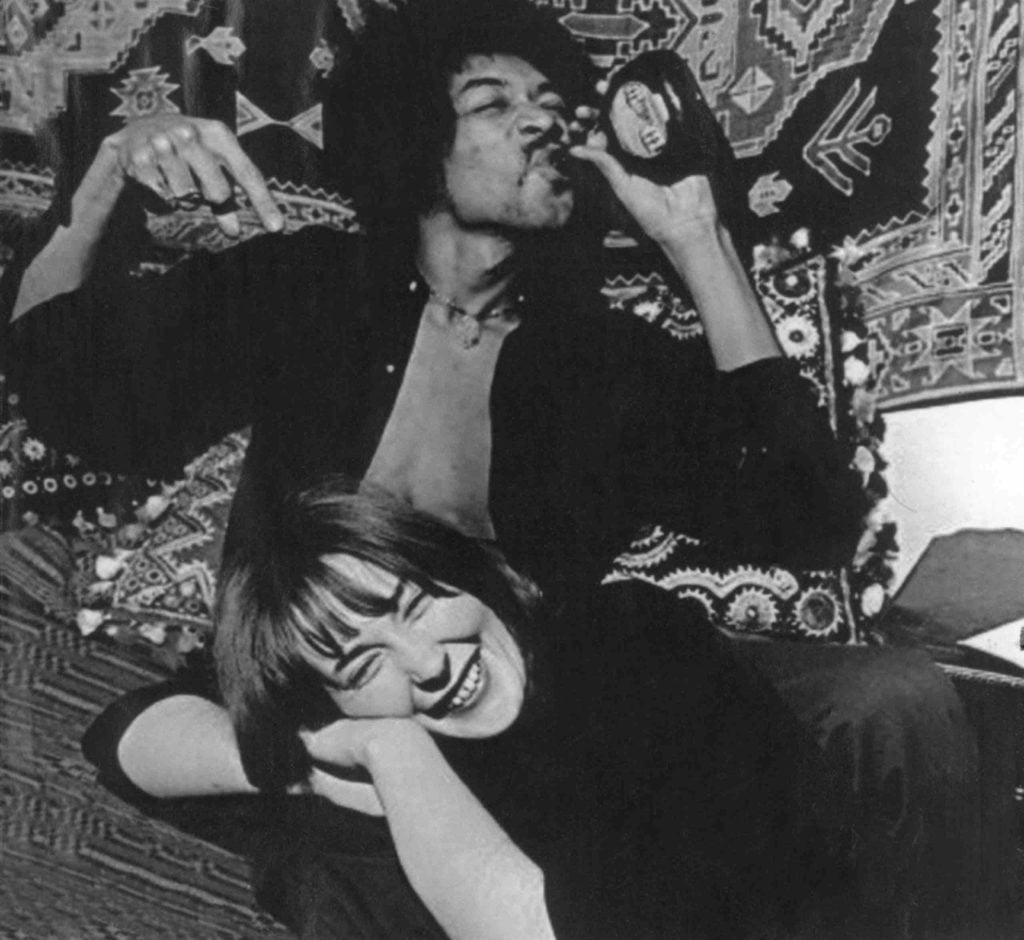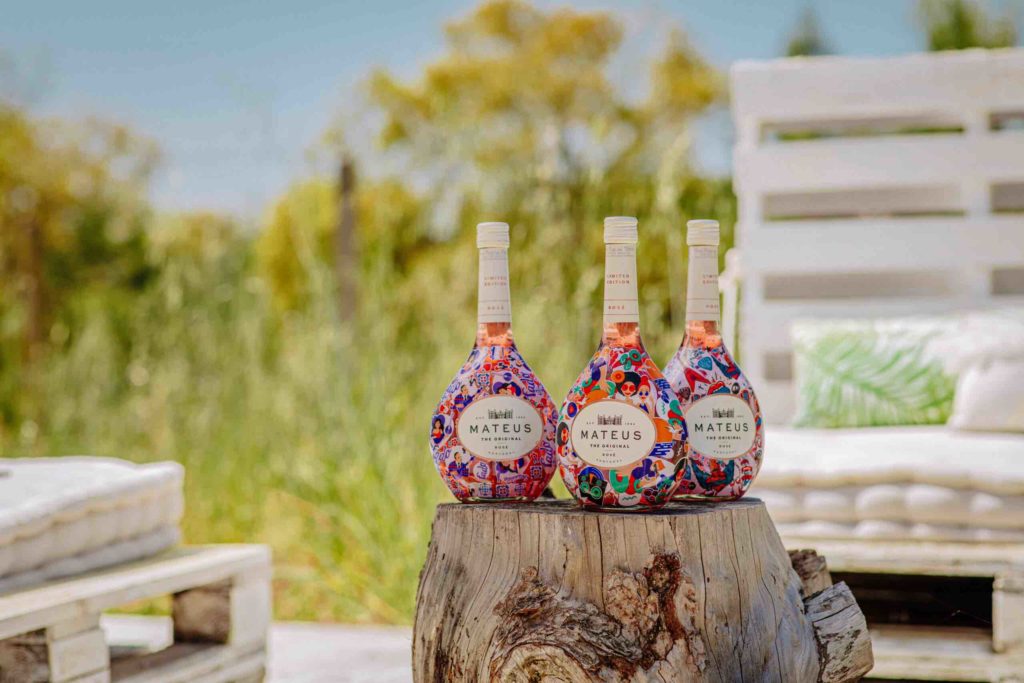Mateus – the success story of Portugal’s best-selling rosé wine

Mateus Rosé is one of the world’s most successful wines. Exported to over 100 markets, it is Portugal’s number one selling wine. More than 20 million bottles of Mateus are sold annually worldwide – that’s one every 38 minutes. Mateus didn’t gain its popularity by chance, it was created by a visionary whose aim was to make a rosé that would draw the world’s attention. And he succeeded. In the 1970s, the rosé was the best-selling wine on the planet! Queen Elizabeth II, Jimi Hendrix and Elton John were among the millions of people Mateus appealed to.
To find out more about the story behind the brand’s success, we talked to Diogo Sepúlveda, head of winemaking for Mateus, Vinho Verde, Bairrada, Dão, and Lisboa, and António Braga, former Sogrape (Mateus) winemaker.
How was Portugal’s first rosé wine created?
Diogo Sepúlveda: Mateus was born in 1942 from the idea of a visionary man, Fernando Van Zeller Guedes, Sogrape’s founder. The company was started with the aim of producing the best wines in the country and spreading them worldwide so that everyone could recognize the potential, diversity and quality of Portugal’s wines.
A man ahead of his time, Fernando dreamed of and made a pink-coloured wine that was slightly fizzy – it was a different and innovative style for the time. From Portugal to the world, Mateus soon became a global reference, with consistency in quality as a premise. 80 years have gone by, but Mateus is committed to reinventing the rosé category, by offering refreshing and fruity wines and promoting a diversity of easy-drinking experiences – everyday rosé wines.
Where does the name Mateus come from?
Diogo Sepúlveda: One of Sogrape’s first vineyards was in Vila Real, in the north of Portugal, more specifically in a small village named Mateus. Curiously, right next to the property was the Palácio de Mateus, a mansion with vineyards around it, once in the hands of Mateus Thane. Inspired by the beauty and majesty of Palácio de Mateus, Fernando van Zeller Guedes made a lifetime deal with Thane that Sogrape would buy his grapes for the production of Mateus wines and in exchange, Thane would authorize use of the image of the mansion on the label. And so it has been until this day!
Why the unusual bottle shape?
Diogo Sepúlveda: It was inspired by the flasks used by soldiers in World War I. But the canteen-shaped bottle also had a strategic purpose – unusual, iconic and disruptive, it always ensured a tactical position on store shelves, being placed in front of taller wine bottles.

Where did the grapes for the first Mateus rosé come from?
Diogo Sepúlveda: In its early days, Mateus was vinified from red grapes grown in vineyards located in high areas of the Douro region, in particular Alvarelhão, Rufete and Mourisco.
How and when did Mateus start gaining in popularity abroad?
Diogo Sepúlveda: Sogrape’s mission was to produce quality Portuguese wines and show them to the world, and Mateus was the starting point. Fernando van Zeller Guedes knew that conquering international markets was the key to success and records tell us that the first samples were shipped to New York in 1943. A year later, Brazil followed.
At the beginning of the 1950’s, the first marketing campaign was launched – Fernando van Zeller sent a box containing two bottles of Mateus rosé to every Portuguese ambassador and consul he could think of, asking them to drink one of them, and pass the other on to someone who could contribute to the promotion and distribution of the brand in the respective countries. It was a tremendous visionary act that became a case study!
In 1953 and 1956, respectively, partnerships with distributors in the USA and UK were established. Mateus was officially conquering the world!
Which turned out to be the best export market for Mateus rosé?
Diogo Sepúlveda: Mateus was very well received in all countries where it was launched, but its popularity in the UK and the English colonies was the main contributor to spreading the success of the brand. This was due to an event involving the Queen of England at some point in the 1960’s. Her Majesty asked for a glass of Mateus at a private party at the Savoy Hotel in London. The wine was not listed on the menu and the hotel manager had to rush out and purchase a bottle in order to satisfy the Queen’s demand. From this moment on, all the best hotels in town got supplied with Mateus and the story became a great advertisement for the brand around the word. Right up until today, the UK has been the number 1 export market for Mateus.
Besides Queen Elizabeth II, is there evidence of other celebrities who were fans of Mateus?
Diogo Sepúlveda: In the 1960s, world famous artists such as Jimi Hendrix, who was photographed at home drinking Mateus, Elton John, Portuguese Fado singer Amália Rodrigues and Nubar Gulbenkian, were known to be Mateus enthusiasts. During the Apollo 8 mission, Commander Frank Borman allegedly said, “My only regret is that when I flew around the moon, I wasn’t drinking Mateus.

Which price range does Mateus rosé sell in?
Diogo Sepúlveda: Mateus Original rosé has a suggested retail price that ranges from €5.99 to €6.49 and Mateus Sparkling Brut from €8.99 to €9.99.
How many products does Mateus have in its portfolio today?
Diogo Sepúlveda: Currently we have Mateus Original, Mateus Medium Sweet, Mateus White, Mateus Sparkling Brut and the vintage wines Mateus Dry and Mateus Family Edition.
Which is your bestseller?
Diogo Sepúlveda: Mateus Original is our number 1 product. But we have been registering growth with some of the other products too, especially the limited editions like the sleeved bottles we released for our 80th anniversary.

How many countries is Mateus exported to today?
Diogo Sepúlveda: Mateus is present in over 100 markets, the most important of which are Portugal, the United Kingdom, Spain, Italy, France, Switzerland, Germany, Belgium, Canada and Australia.
Which consumer audiences are you targeting currently?
Diogo Sepúlveda: Mateus is a brand with universal reach in the journey through the world of wine. People who are starting out on their journey may try Mateus and enjoy it, thus remaining faithful to it for the rest of their lives. But there are many others who ‘visit’ other types of wines and then return to Mateus when the occasion calls for it.
So, the target runs from urban consumers, who follow the world through social media to those who value privacy and appreciate time out to enjoy a great landscape in the company of loved ones in a relaxing way.
Which were the biggest challenges for you as Mateus’ winemakers?
António Braga: I was the Mateus winemaker for five years, and it was an incredible experience. This brand is much more than a wine, it’s a symbol of Sogrape’s culture and DNA. It is innovative, customer-driven, iconic and definitely a crowd-pleaser.
Production is consistent and efficient and contrary to some people’s ideas, it is very reliant on grape quality and terroir. Of course, it is technologically modern and consistent, but nevertheless a rosé made from a blend of Portuguese grape varieties sourced in the cooler climate vineyard sites in Portugal.
I started working at the winery in 2017 and the biggest challenge the team and I faced was to find the balance between Mateus’ traditional style and new market trends at the time. The rosé category has been strongly influenced by Provence’s dry, pale style and ways of consuming rosé wines were changing – there were a lot of new developments for Mateus to adapt to.
Diogo Sepúlveda: For me it is a great source of pride and responsibility to lead the current winemaking team responsible for Mateus’ production. My first concern when I accepted this position was to learn more about the source of our grapes. It’s crucial for the sustainability of Mateus’ production to establish good and long-lasting relationships with our grape suppliers, by ensuring sustainable and good agricultural and winemaking practices.
Also, understanding how to continue to increase the quality of the product, with greater production efficiency and more modernization and automation of our operation flow, was similarly crucial.
Mateus has been a leading Portuguese brand for decades and to retain that status is a great challenge and responsibility. Mateus must continue to innovate, it is part of the brand’s DNA to define trends and stay ahead of the times.
What does the future hold for Mateus?
Diogo Sepúlveda: In 2022 we celebrated 80 years of success and are already looking forward to celebrating our 100thanniversary. Therefore, the next two decades will be of the utmost relevance in acquiring new consumers and markets.
Valentina Phillips


